Tesco Operations Management and Continuous Improvement Plan
VerifiedAdded on 2023/01/06
|16
|4271
|74
Report
AI Summary
This report delves into the realm of operations management, examining its core principles and their practical application within an organizational context. The report focuses on Tesco, a prominent retail giant, as a case study to illustrate these concepts. It begins with a comprehensive review and critique of operations management principles, including scientific management, lean production, and Six Sigma methodologies. The analysis covers how these principles can be implemented to enhance efficiency and effectiveness. Furthermore, the report proposes a detailed continuous improvement plan tailored for Tesco, incorporating lean principles to eliminate waste, optimize processes, and improve overall performance. The plan addresses key areas such as value identification, value stream mapping, flow creation, establishing pull, and the pursuit of perfection. The report also includes an analysis of the project life cycle and its effectiveness in the context of the Olympic Delivery Authority (ODA), providing insights into project management strategies and their impact on achieving specific goals.
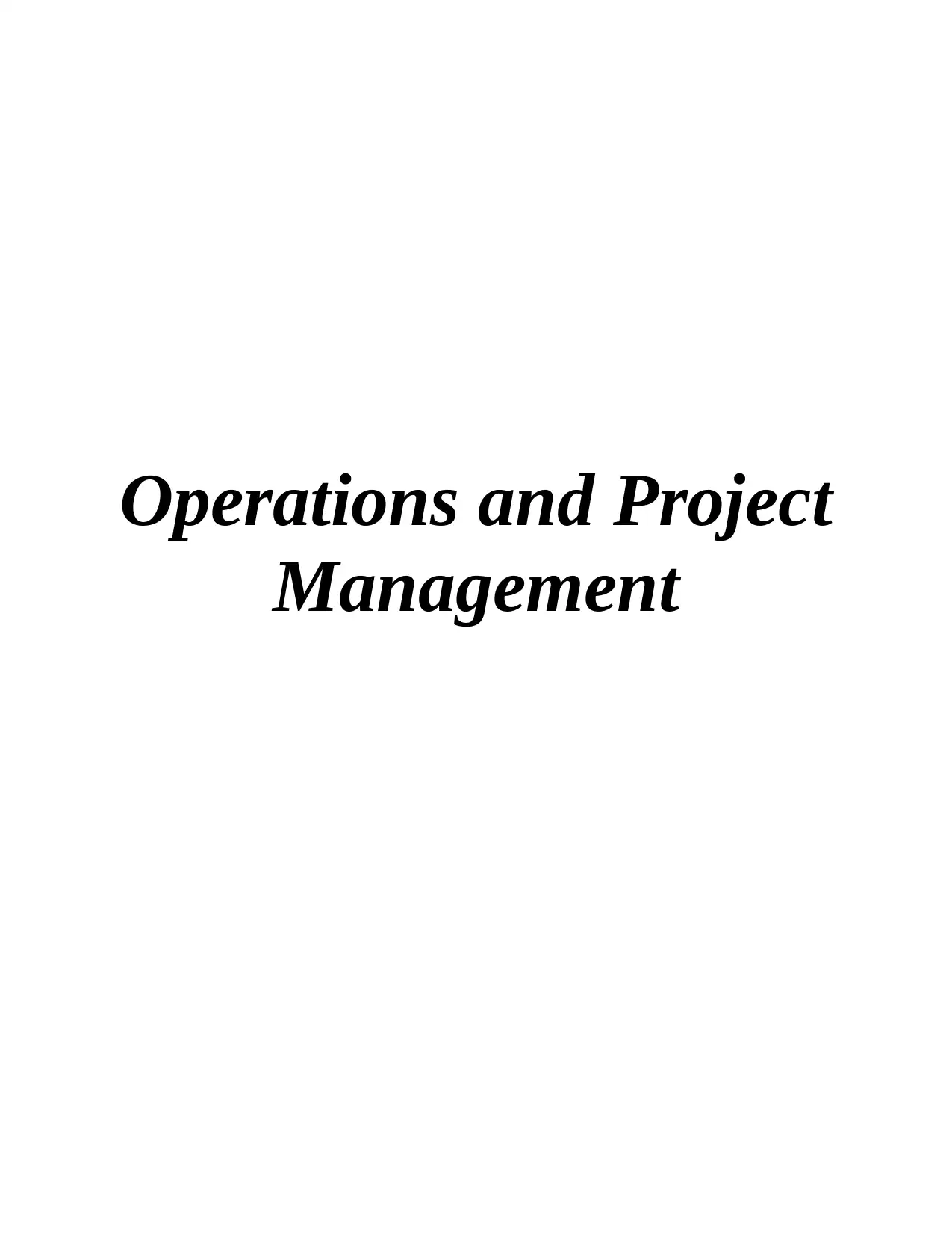
Operations and Project
Management
Management
Paraphrase This Document
Need a fresh take? Get an instant paraphrase of this document with our AI Paraphraser
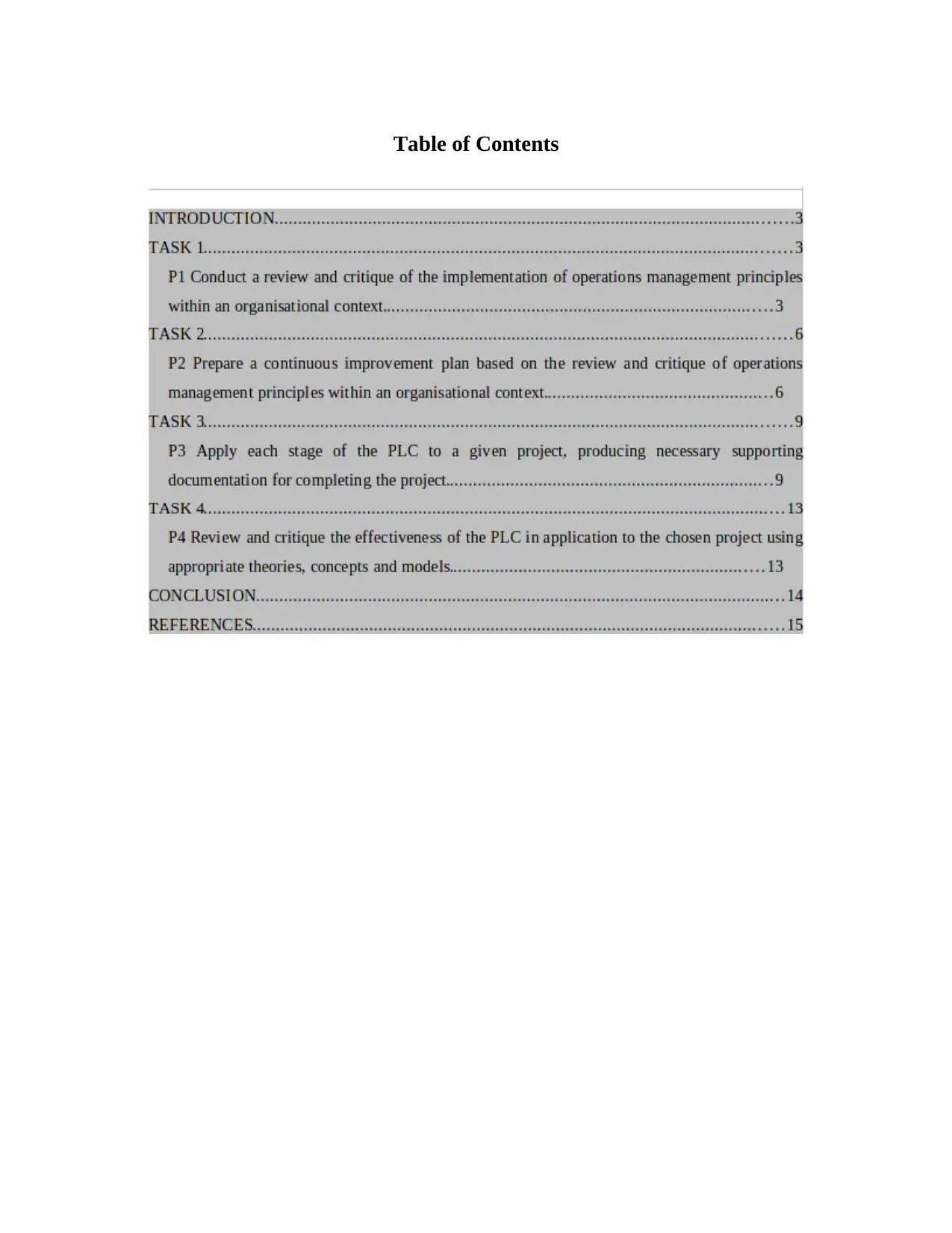
Table of Contents
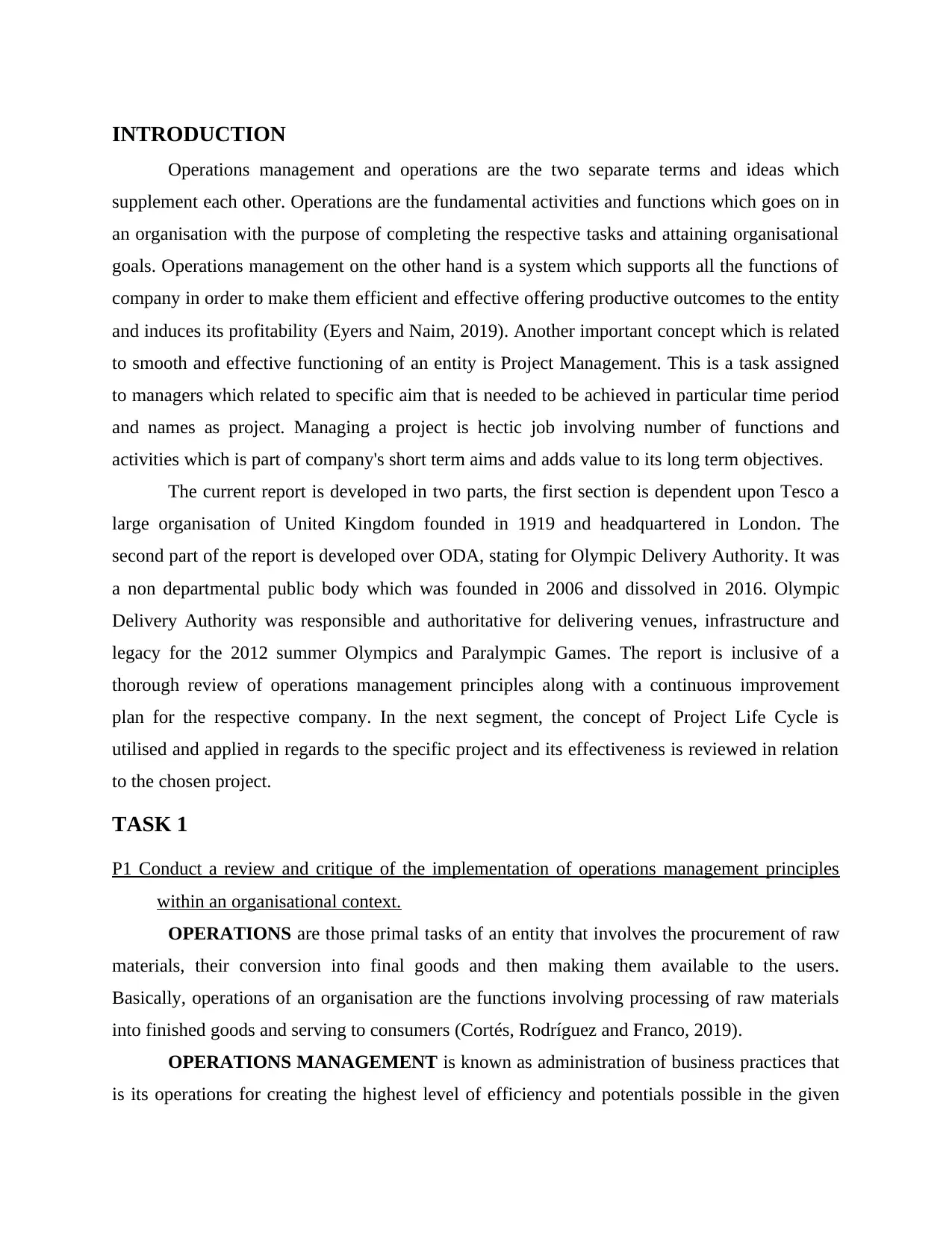
INTRODUCTION
Operations management and operations are the two separate terms and ideas which
supplement each other. Operations are the fundamental activities and functions which goes on in
an organisation with the purpose of completing the respective tasks and attaining organisational
goals. Operations management on the other hand is a system which supports all the functions of
company in order to make them efficient and effective offering productive outcomes to the entity
and induces its profitability (Eyers and Naim, 2019). Another important concept which is related
to smooth and effective functioning of an entity is Project Management. This is a task assigned
to managers which related to specific aim that is needed to be achieved in particular time period
and names as project. Managing a project is hectic job involving number of functions and
activities which is part of company's short term aims and adds value to its long term objectives.
The current report is developed in two parts, the first section is dependent upon Tesco a
large organisation of United Kingdom founded in 1919 and headquartered in London. The
second part of the report is developed over ODA, stating for Olympic Delivery Authority. It was
a non departmental public body which was founded in 2006 and dissolved in 2016. Olympic
Delivery Authority was responsible and authoritative for delivering venues, infrastructure and
legacy for the 2012 summer Olympics and Paralympic Games. The report is inclusive of a
thorough review of operations management principles along with a continuous improvement
plan for the respective company. In the next segment, the concept of Project Life Cycle is
utilised and applied in regards to the specific project and its effectiveness is reviewed in relation
to the chosen project.
TASK 1
P1 Conduct a review and critique of the implementation of operations management principles
within an organisational context.
OPERATIONS are those primal tasks of an entity that involves the procurement of raw
materials, their conversion into final goods and then making them available to the users.
Basically, operations of an organisation are the functions involving processing of raw materials
into finished goods and serving to consumers (Cortés, Rodríguez and Franco, 2019).
OPERATIONS MANAGEMENT is known as administration of business practices that
is its operations for creating the highest level of efficiency and potentials possible in the given
Operations management and operations are the two separate terms and ideas which
supplement each other. Operations are the fundamental activities and functions which goes on in
an organisation with the purpose of completing the respective tasks and attaining organisational
goals. Operations management on the other hand is a system which supports all the functions of
company in order to make them efficient and effective offering productive outcomes to the entity
and induces its profitability (Eyers and Naim, 2019). Another important concept which is related
to smooth and effective functioning of an entity is Project Management. This is a task assigned
to managers which related to specific aim that is needed to be achieved in particular time period
and names as project. Managing a project is hectic job involving number of functions and
activities which is part of company's short term aims and adds value to its long term objectives.
The current report is developed in two parts, the first section is dependent upon Tesco a
large organisation of United Kingdom founded in 1919 and headquartered in London. The
second part of the report is developed over ODA, stating for Olympic Delivery Authority. It was
a non departmental public body which was founded in 2006 and dissolved in 2016. Olympic
Delivery Authority was responsible and authoritative for delivering venues, infrastructure and
legacy for the 2012 summer Olympics and Paralympic Games. The report is inclusive of a
thorough review of operations management principles along with a continuous improvement
plan for the respective company. In the next segment, the concept of Project Life Cycle is
utilised and applied in regards to the specific project and its effectiveness is reviewed in relation
to the chosen project.
TASK 1
P1 Conduct a review and critique of the implementation of operations management principles
within an organisational context.
OPERATIONS are those primal tasks of an entity that involves the procurement of raw
materials, their conversion into final goods and then making them available to the users.
Basically, operations of an organisation are the functions involving processing of raw materials
into finished goods and serving to consumers (Cortés, Rodríguez and Franco, 2019).
OPERATIONS MANAGEMENT is known as administration of business practices that
is its operations for creating the highest level of efficiency and potentials possible in the given
⊘ This is a preview!⊘
Do you want full access?
Subscribe today to unlock all pages.

Trusted by 1+ million students worldwide
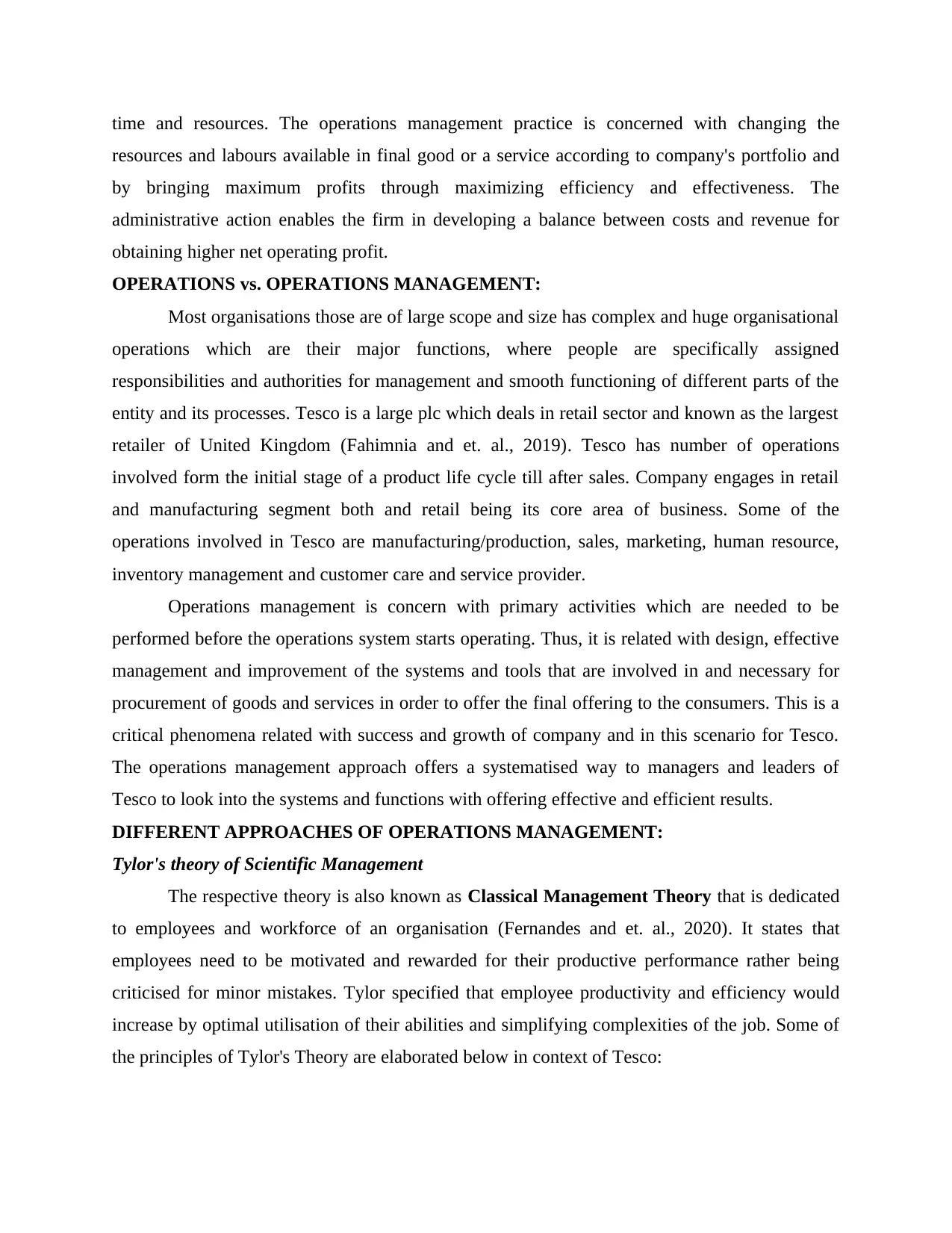
time and resources. The operations management practice is concerned with changing the
resources and labours available in final good or a service according to company's portfolio and
by bringing maximum profits through maximizing efficiency and effectiveness. The
administrative action enables the firm in developing a balance between costs and revenue for
obtaining higher net operating profit.
OPERATIONS vs. OPERATIONS MANAGEMENT:
Most organisations those are of large scope and size has complex and huge organisational
operations which are their major functions, where people are specifically assigned
responsibilities and authorities for management and smooth functioning of different parts of the
entity and its processes. Tesco is a large plc which deals in retail sector and known as the largest
retailer of United Kingdom (Fahimnia and et. al., 2019). Tesco has number of operations
involved form the initial stage of a product life cycle till after sales. Company engages in retail
and manufacturing segment both and retail being its core area of business. Some of the
operations involved in Tesco are manufacturing/production, sales, marketing, human resource,
inventory management and customer care and service provider.
Operations management is concern with primary activities which are needed to be
performed before the operations system starts operating. Thus, it is related with design, effective
management and improvement of the systems and tools that are involved in and necessary for
procurement of goods and services in order to offer the final offering to the consumers. This is a
critical phenomena related with success and growth of company and in this scenario for Tesco.
The operations management approach offers a systematised way to managers and leaders of
Tesco to look into the systems and functions with offering effective and efficient results.
DIFFERENT APPROACHES OF OPERATIONS MANAGEMENT:
Tylor's theory of Scientific Management
The respective theory is also known as Classical Management Theory that is dedicated
to employees and workforce of an organisation (Fernandes and et. al., 2020). It states that
employees need to be motivated and rewarded for their productive performance rather being
criticised for minor mistakes. Tylor specified that employee productivity and efficiency would
increase by optimal utilisation of their abilities and simplifying complexities of the job. Some of
the principles of Tylor's Theory are elaborated below in context of Tesco:
resources and labours available in final good or a service according to company's portfolio and
by bringing maximum profits through maximizing efficiency and effectiveness. The
administrative action enables the firm in developing a balance between costs and revenue for
obtaining higher net operating profit.
OPERATIONS vs. OPERATIONS MANAGEMENT:
Most organisations those are of large scope and size has complex and huge organisational
operations which are their major functions, where people are specifically assigned
responsibilities and authorities for management and smooth functioning of different parts of the
entity and its processes. Tesco is a large plc which deals in retail sector and known as the largest
retailer of United Kingdom (Fahimnia and et. al., 2019). Tesco has number of operations
involved form the initial stage of a product life cycle till after sales. Company engages in retail
and manufacturing segment both and retail being its core area of business. Some of the
operations involved in Tesco are manufacturing/production, sales, marketing, human resource,
inventory management and customer care and service provider.
Operations management is concern with primary activities which are needed to be
performed before the operations system starts operating. Thus, it is related with design, effective
management and improvement of the systems and tools that are involved in and necessary for
procurement of goods and services in order to offer the final offering to the consumers. This is a
critical phenomena related with success and growth of company and in this scenario for Tesco.
The operations management approach offers a systematised way to managers and leaders of
Tesco to look into the systems and functions with offering effective and efficient results.
DIFFERENT APPROACHES OF OPERATIONS MANAGEMENT:
Tylor's theory of Scientific Management
The respective theory is also known as Classical Management Theory that is dedicated
to employees and workforce of an organisation (Fernandes and et. al., 2020). It states that
employees need to be motivated and rewarded for their productive performance rather being
criticised for minor mistakes. Tylor specified that employee productivity and efficiency would
increase by optimal utilisation of their abilities and simplifying complexities of the job. Some of
the principles of Tylor's Theory are elaborated below in context of Tesco:
Paraphrase This Document
Need a fresh take? Get an instant paraphrase of this document with our AI Paraphraser
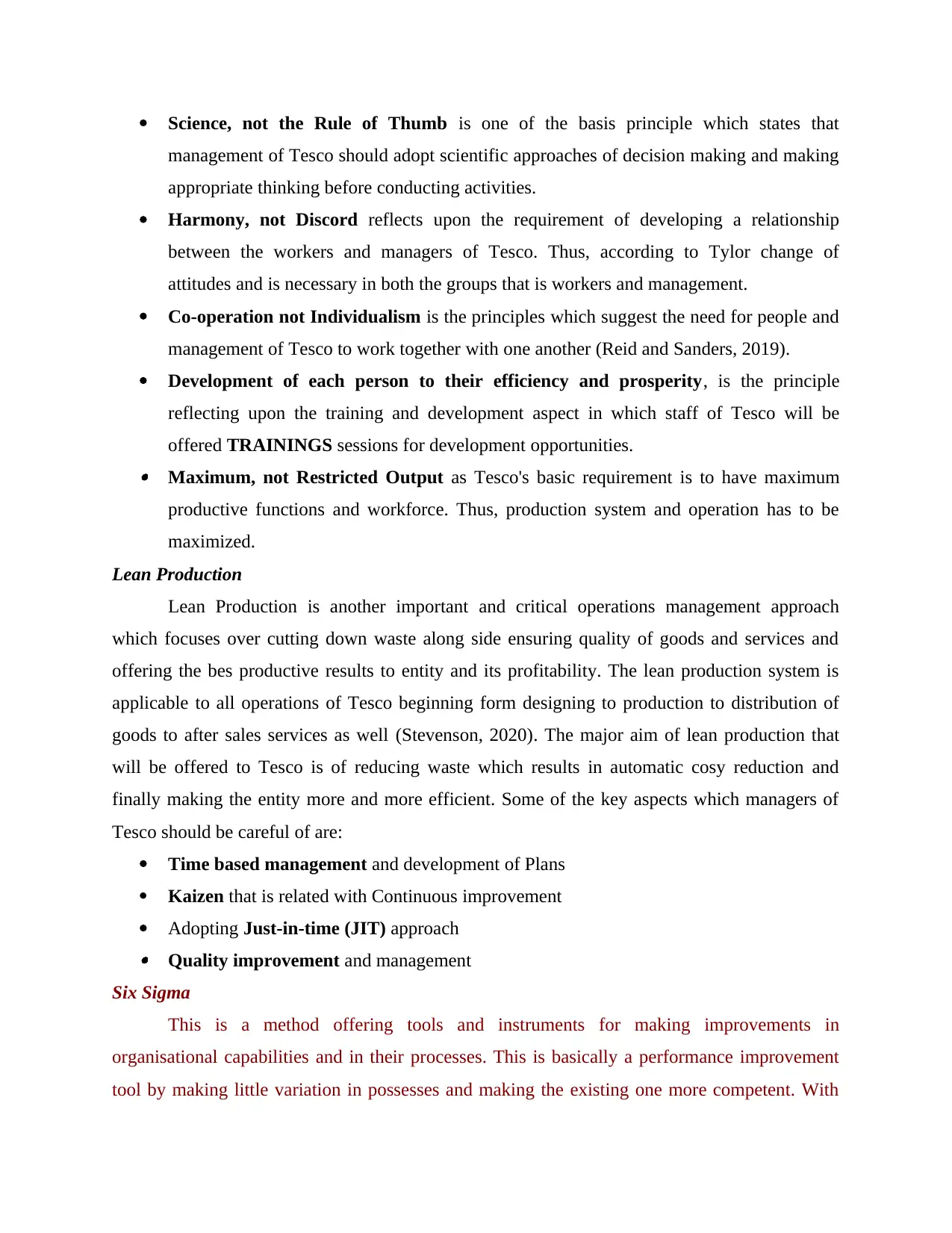
Science, not the Rule of Thumb is one of the basis principle which states that
management of Tesco should adopt scientific approaches of decision making and making
appropriate thinking before conducting activities.
Harmony, not Discord reflects upon the requirement of developing a relationship
between the workers and managers of Tesco. Thus, according to Tylor change of
attitudes and is necessary in both the groups that is workers and management.
Co-operation not Individualism is the principles which suggest the need for people and
management of Tesco to work together with one another (Reid and Sanders, 2019).
Development of each person to their efficiency and prosperity, is the principle
reflecting upon the training and development aspect in which staff of Tesco will be
offered TRAININGS sessions for development opportunities. Maximum, not Restricted Output as Tesco's basic requirement is to have maximum
productive functions and workforce. Thus, production system and operation has to be
maximized.
Lean Production
Lean Production is another important and critical operations management approach
which focuses over cutting down waste along side ensuring quality of goods and services and
offering the bes productive results to entity and its profitability. The lean production system is
applicable to all operations of Tesco beginning form designing to production to distribution of
goods to after sales services as well (Stevenson, 2020). The major aim of lean production that
will be offered to Tesco is of reducing waste which results in automatic cosy reduction and
finally making the entity more and more efficient. Some of the key aspects which managers of
Tesco should be careful of are:
Time based management and development of Plans
Kaizen that is related with Continuous improvement
Adopting Just-in-time (JIT) approach Quality improvement and management
Six Sigma
This is a method offering tools and instruments for making improvements in
organisational capabilities and in their processes. This is basically a performance improvement
tool by making little variation in possesses and making the existing one more competent. With
management of Tesco should adopt scientific approaches of decision making and making
appropriate thinking before conducting activities.
Harmony, not Discord reflects upon the requirement of developing a relationship
between the workers and managers of Tesco. Thus, according to Tylor change of
attitudes and is necessary in both the groups that is workers and management.
Co-operation not Individualism is the principles which suggest the need for people and
management of Tesco to work together with one another (Reid and Sanders, 2019).
Development of each person to their efficiency and prosperity, is the principle
reflecting upon the training and development aspect in which staff of Tesco will be
offered TRAININGS sessions for development opportunities. Maximum, not Restricted Output as Tesco's basic requirement is to have maximum
productive functions and workforce. Thus, production system and operation has to be
maximized.
Lean Production
Lean Production is another important and critical operations management approach
which focuses over cutting down waste along side ensuring quality of goods and services and
offering the bes productive results to entity and its profitability. The lean production system is
applicable to all operations of Tesco beginning form designing to production to distribution of
goods to after sales services as well (Stevenson, 2020). The major aim of lean production that
will be offered to Tesco is of reducing waste which results in automatic cosy reduction and
finally making the entity more and more efficient. Some of the key aspects which managers of
Tesco should be careful of are:
Time based management and development of Plans
Kaizen that is related with Continuous improvement
Adopting Just-in-time (JIT) approach Quality improvement and management
Six Sigma
This is a method offering tools and instruments for making improvements in
organisational capabilities and in their processes. This is basically a performance improvement
tool by making little variation in possesses and making the existing one more competent. With
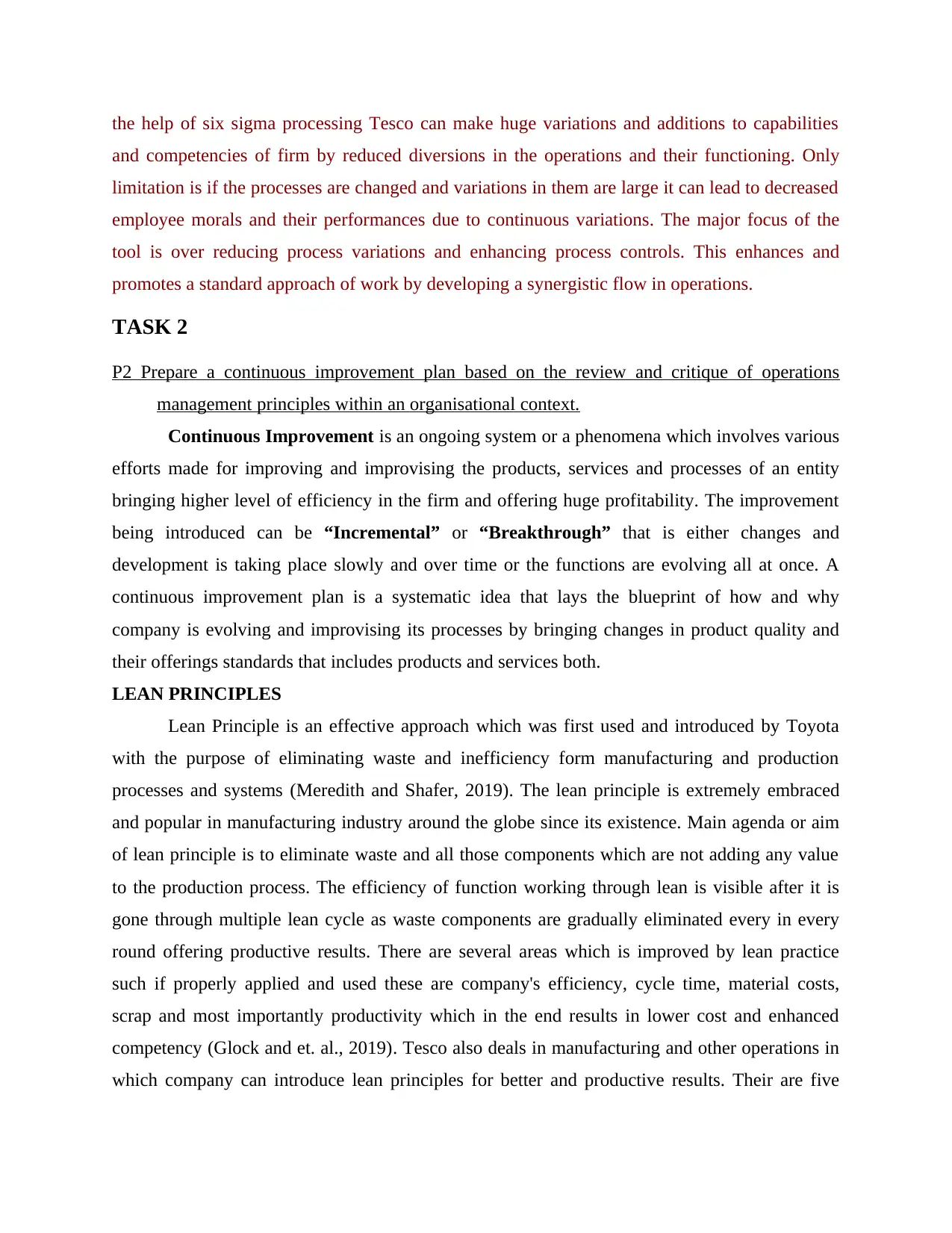
the help of six sigma processing Tesco can make huge variations and additions to capabilities
and competencies of firm by reduced diversions in the operations and their functioning. Only
limitation is if the processes are changed and variations in them are large it can lead to decreased
employee morals and their performances due to continuous variations. The major focus of the
tool is over reducing process variations and enhancing process controls. This enhances and
promotes a standard approach of work by developing a synergistic flow in operations.
TASK 2
P2 Prepare a continuous improvement plan based on the review and critique of operations
management principles within an organisational context.
Continuous Improvement is an ongoing system or a phenomena which involves various
efforts made for improving and improvising the products, services and processes of an entity
bringing higher level of efficiency in the firm and offering huge profitability. The improvement
being introduced can be “Incremental” or “Breakthrough” that is either changes and
development is taking place slowly and over time or the functions are evolving all at once. A
continuous improvement plan is a systematic idea that lays the blueprint of how and why
company is evolving and improvising its processes by bringing changes in product quality and
their offerings standards that includes products and services both.
LEAN PRINCIPLES
Lean Principle is an effective approach which was first used and introduced by Toyota
with the purpose of eliminating waste and inefficiency form manufacturing and production
processes and systems (Meredith and Shafer, 2019). The lean principle is extremely embraced
and popular in manufacturing industry around the globe since its existence. Main agenda or aim
of lean principle is to eliminate waste and all those components which are not adding any value
to the production process. The efficiency of function working through lean is visible after it is
gone through multiple lean cycle as waste components are gradually eliminated every in every
round offering productive results. There are several areas which is improved by lean practice
such if properly applied and used these are company's efficiency, cycle time, material costs,
scrap and most importantly productivity which in the end results in lower cost and enhanced
competency (Glock and et. al., 2019). Tesco also deals in manufacturing and other operations in
which company can introduce lean principles for better and productive results. Their are five
and competencies of firm by reduced diversions in the operations and their functioning. Only
limitation is if the processes are changed and variations in them are large it can lead to decreased
employee morals and their performances due to continuous variations. The major focus of the
tool is over reducing process variations and enhancing process controls. This enhances and
promotes a standard approach of work by developing a synergistic flow in operations.
TASK 2
P2 Prepare a continuous improvement plan based on the review and critique of operations
management principles within an organisational context.
Continuous Improvement is an ongoing system or a phenomena which involves various
efforts made for improving and improvising the products, services and processes of an entity
bringing higher level of efficiency in the firm and offering huge profitability. The improvement
being introduced can be “Incremental” or “Breakthrough” that is either changes and
development is taking place slowly and over time or the functions are evolving all at once. A
continuous improvement plan is a systematic idea that lays the blueprint of how and why
company is evolving and improvising its processes by bringing changes in product quality and
their offerings standards that includes products and services both.
LEAN PRINCIPLES
Lean Principle is an effective approach which was first used and introduced by Toyota
with the purpose of eliminating waste and inefficiency form manufacturing and production
processes and systems (Meredith and Shafer, 2019). The lean principle is extremely embraced
and popular in manufacturing industry around the globe since its existence. Main agenda or aim
of lean principle is to eliminate waste and all those components which are not adding any value
to the production process. The efficiency of function working through lean is visible after it is
gone through multiple lean cycle as waste components are gradually eliminated every in every
round offering productive results. There are several areas which is improved by lean practice
such if properly applied and used these are company's efficiency, cycle time, material costs,
scrap and most importantly productivity which in the end results in lower cost and enhanced
competency (Glock and et. al., 2019). Tesco also deals in manufacturing and other operations in
which company can introduce lean principles for better and productive results. Their are five
⊘ This is a preview!⊘
Do you want full access?
Subscribe today to unlock all pages.

Trusted by 1+ million students worldwide
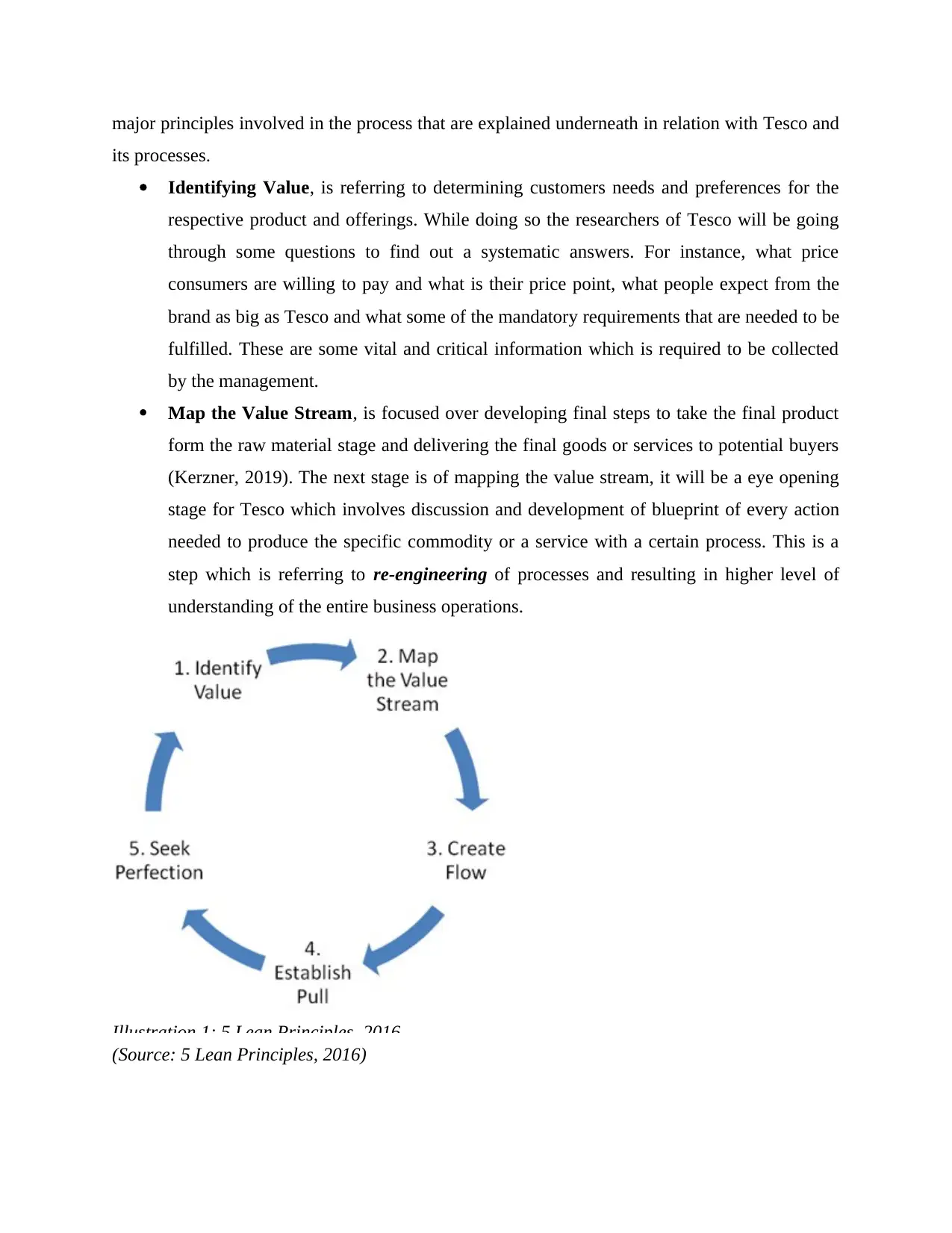
major principles involved in the process that are explained underneath in relation with Tesco and
its processes.
Identifying Value, is referring to determining customers needs and preferences for the
respective product and offerings. While doing so the researchers of Tesco will be going
through some questions to find out a systematic answers. For instance, what price
consumers are willing to pay and what is their price point, what people expect from the
brand as big as Tesco and what some of the mandatory requirements that are needed to be
fulfilled. These are some vital and critical information which is required to be collected
by the management.
Map the Value Stream, is focused over developing final steps to take the final product
form the raw material stage and delivering the final goods or services to potential buyers
(Kerzner, 2019). The next stage is of mapping the value stream, it will be a eye opening
stage for Tesco which involves discussion and development of blueprint of every action
needed to produce the specific commodity or a service with a certain process. This is a
step which is referring to re-engineering of processes and resulting in higher level of
understanding of the entire business operations.
Illustration 1: 5 Lean Principles, 2016
(Source: 5 Lean Principles, 2016)
its processes.
Identifying Value, is referring to determining customers needs and preferences for the
respective product and offerings. While doing so the researchers of Tesco will be going
through some questions to find out a systematic answers. For instance, what price
consumers are willing to pay and what is their price point, what people expect from the
brand as big as Tesco and what some of the mandatory requirements that are needed to be
fulfilled. These are some vital and critical information which is required to be collected
by the management.
Map the Value Stream, is focused over developing final steps to take the final product
form the raw material stage and delivering the final goods or services to potential buyers
(Kerzner, 2019). The next stage is of mapping the value stream, it will be a eye opening
stage for Tesco which involves discussion and development of blueprint of every action
needed to produce the specific commodity or a service with a certain process. This is a
step which is referring to re-engineering of processes and resulting in higher level of
understanding of the entire business operations.
Illustration 1: 5 Lean Principles, 2016
(Source: 5 Lean Principles, 2016)
Paraphrase This Document
Need a fresh take? Get an instant paraphrase of this document with our AI Paraphraser
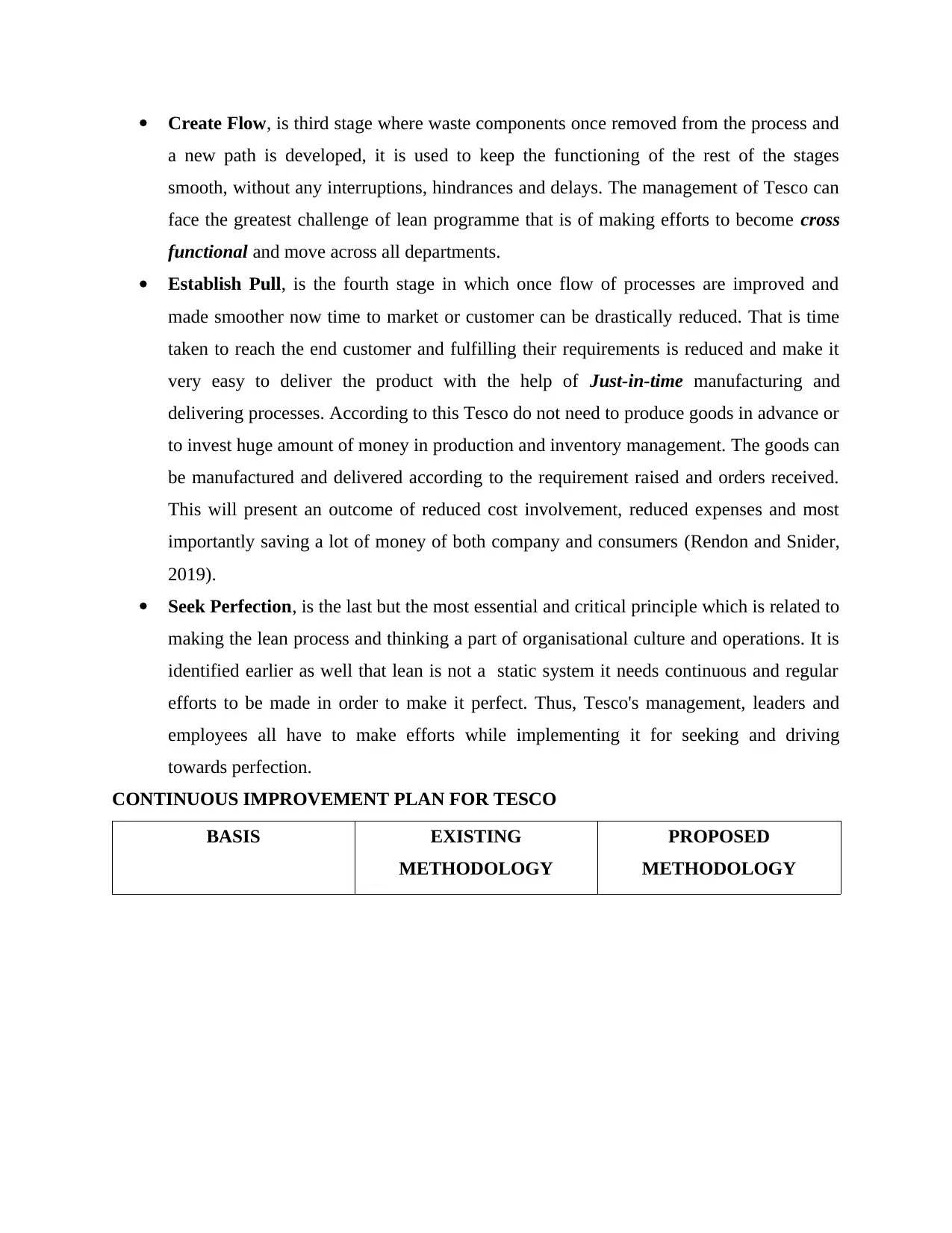
Create Flow, is third stage where waste components once removed from the process and
a new path is developed, it is used to keep the functioning of the rest of the stages
smooth, without any interruptions, hindrances and delays. The management of Tesco can
face the greatest challenge of lean programme that is of making efforts to become cross
functional and move across all departments.
Establish Pull, is the fourth stage in which once flow of processes are improved and
made smoother now time to market or customer can be drastically reduced. That is time
taken to reach the end customer and fulfilling their requirements is reduced and make it
very easy to deliver the product with the help of Just-in-time manufacturing and
delivering processes. According to this Tesco do not need to produce goods in advance or
to invest huge amount of money in production and inventory management. The goods can
be manufactured and delivered according to the requirement raised and orders received.
This will present an outcome of reduced cost involvement, reduced expenses and most
importantly saving a lot of money of both company and consumers (Rendon and Snider,
2019).
Seek Perfection, is the last but the most essential and critical principle which is related to
making the lean process and thinking a part of organisational culture and operations. It is
identified earlier as well that lean is not a static system it needs continuous and regular
efforts to be made in order to make it perfect. Thus, Tesco's management, leaders and
employees all have to make efforts while implementing it for seeking and driving
towards perfection.
CONTINUOUS IMPROVEMENT PLAN FOR TESCO
BASIS EXISTING
METHODOLOGY
PROPOSED
METHODOLOGY
a new path is developed, it is used to keep the functioning of the rest of the stages
smooth, without any interruptions, hindrances and delays. The management of Tesco can
face the greatest challenge of lean programme that is of making efforts to become cross
functional and move across all departments.
Establish Pull, is the fourth stage in which once flow of processes are improved and
made smoother now time to market or customer can be drastically reduced. That is time
taken to reach the end customer and fulfilling their requirements is reduced and make it
very easy to deliver the product with the help of Just-in-time manufacturing and
delivering processes. According to this Tesco do not need to produce goods in advance or
to invest huge amount of money in production and inventory management. The goods can
be manufactured and delivered according to the requirement raised and orders received.
This will present an outcome of reduced cost involvement, reduced expenses and most
importantly saving a lot of money of both company and consumers (Rendon and Snider,
2019).
Seek Perfection, is the last but the most essential and critical principle which is related to
making the lean process and thinking a part of organisational culture and operations. It is
identified earlier as well that lean is not a static system it needs continuous and regular
efforts to be made in order to make it perfect. Thus, Tesco's management, leaders and
employees all have to make efforts while implementing it for seeking and driving
towards perfection.
CONTINUOUS IMPROVEMENT PLAN FOR TESCO
BASIS EXISTING
METHODOLOGY
PROPOSED
METHODOLOGY
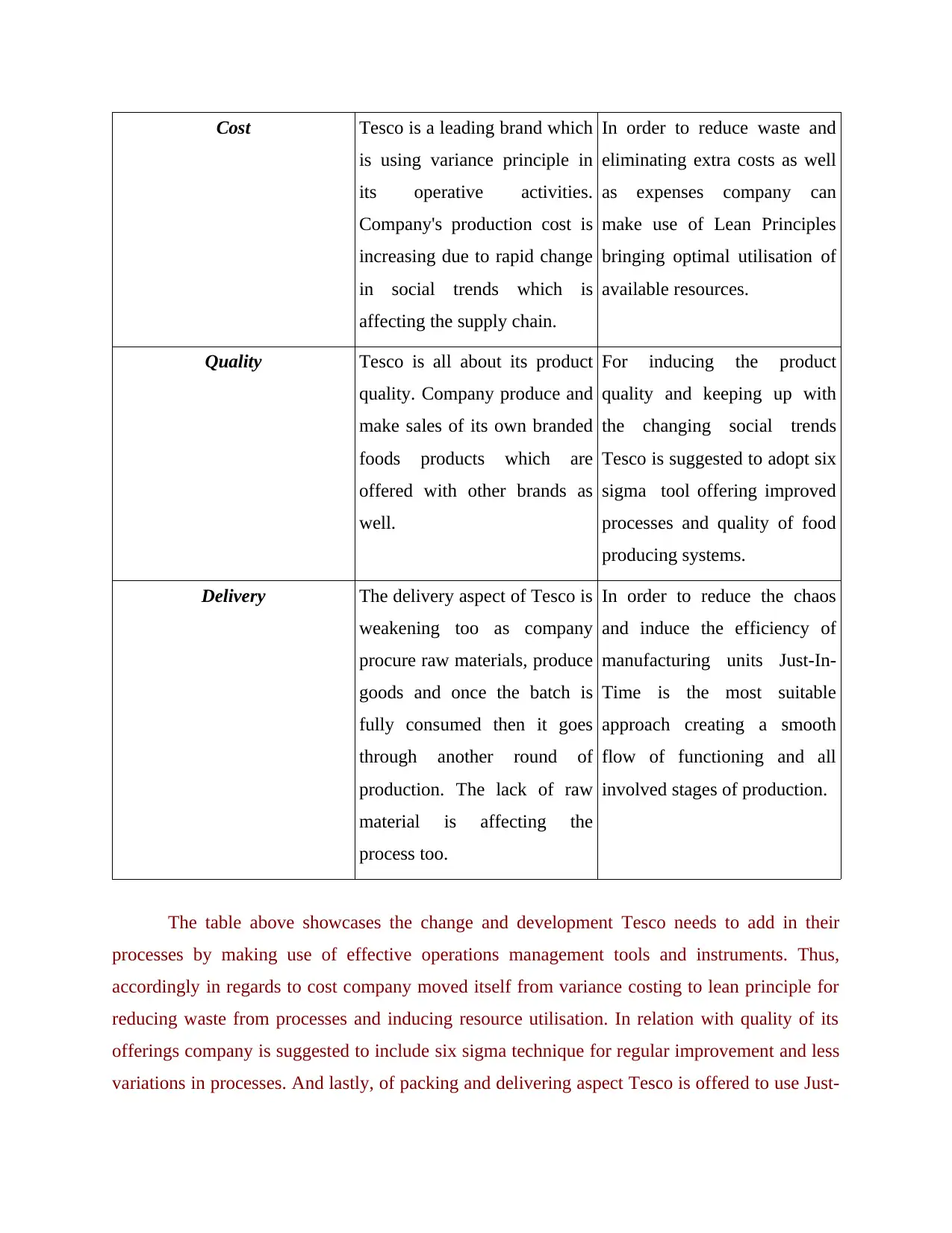
Cost Tesco is a leading brand which
is using variance principle in
its operative activities.
Company's production cost is
increasing due to rapid change
in social trends which is
affecting the supply chain.
In order to reduce waste and
eliminating extra costs as well
as expenses company can
make use of Lean Principles
bringing optimal utilisation of
available resources.
Quality Tesco is all about its product
quality. Company produce and
make sales of its own branded
foods products which are
offered with other brands as
well.
For inducing the product
quality and keeping up with
the changing social trends
Tesco is suggested to adopt six
sigma tool offering improved
processes and quality of food
producing systems.
Delivery The delivery aspect of Tesco is
weakening too as company
procure raw materials, produce
goods and once the batch is
fully consumed then it goes
through another round of
production. The lack of raw
material is affecting the
process too.
In order to reduce the chaos
and induce the efficiency of
manufacturing units Just-In-
Time is the most suitable
approach creating a smooth
flow of functioning and all
involved stages of production.
The table above showcases the change and development Tesco needs to add in their
processes by making use of effective operations management tools and instruments. Thus,
accordingly in regards to cost company moved itself from variance costing to lean principle for
reducing waste from processes and inducing resource utilisation. In relation with quality of its
offerings company is suggested to include six sigma technique for regular improvement and less
variations in processes. And lastly, of packing and delivering aspect Tesco is offered to use Just-
is using variance principle in
its operative activities.
Company's production cost is
increasing due to rapid change
in social trends which is
affecting the supply chain.
In order to reduce waste and
eliminating extra costs as well
as expenses company can
make use of Lean Principles
bringing optimal utilisation of
available resources.
Quality Tesco is all about its product
quality. Company produce and
make sales of its own branded
foods products which are
offered with other brands as
well.
For inducing the product
quality and keeping up with
the changing social trends
Tesco is suggested to adopt six
sigma tool offering improved
processes and quality of food
producing systems.
Delivery The delivery aspect of Tesco is
weakening too as company
procure raw materials, produce
goods and once the batch is
fully consumed then it goes
through another round of
production. The lack of raw
material is affecting the
process too.
In order to reduce the chaos
and induce the efficiency of
manufacturing units Just-In-
Time is the most suitable
approach creating a smooth
flow of functioning and all
involved stages of production.
The table above showcases the change and development Tesco needs to add in their
processes by making use of effective operations management tools and instruments. Thus,
accordingly in regards to cost company moved itself from variance costing to lean principle for
reducing waste from processes and inducing resource utilisation. In relation with quality of its
offerings company is suggested to include six sigma technique for regular improvement and less
variations in processes. And lastly, of packing and delivering aspect Tesco is offered to use Just-
⊘ This is a preview!⊘
Do you want full access?
Subscribe today to unlock all pages.

Trusted by 1+ million students worldwide
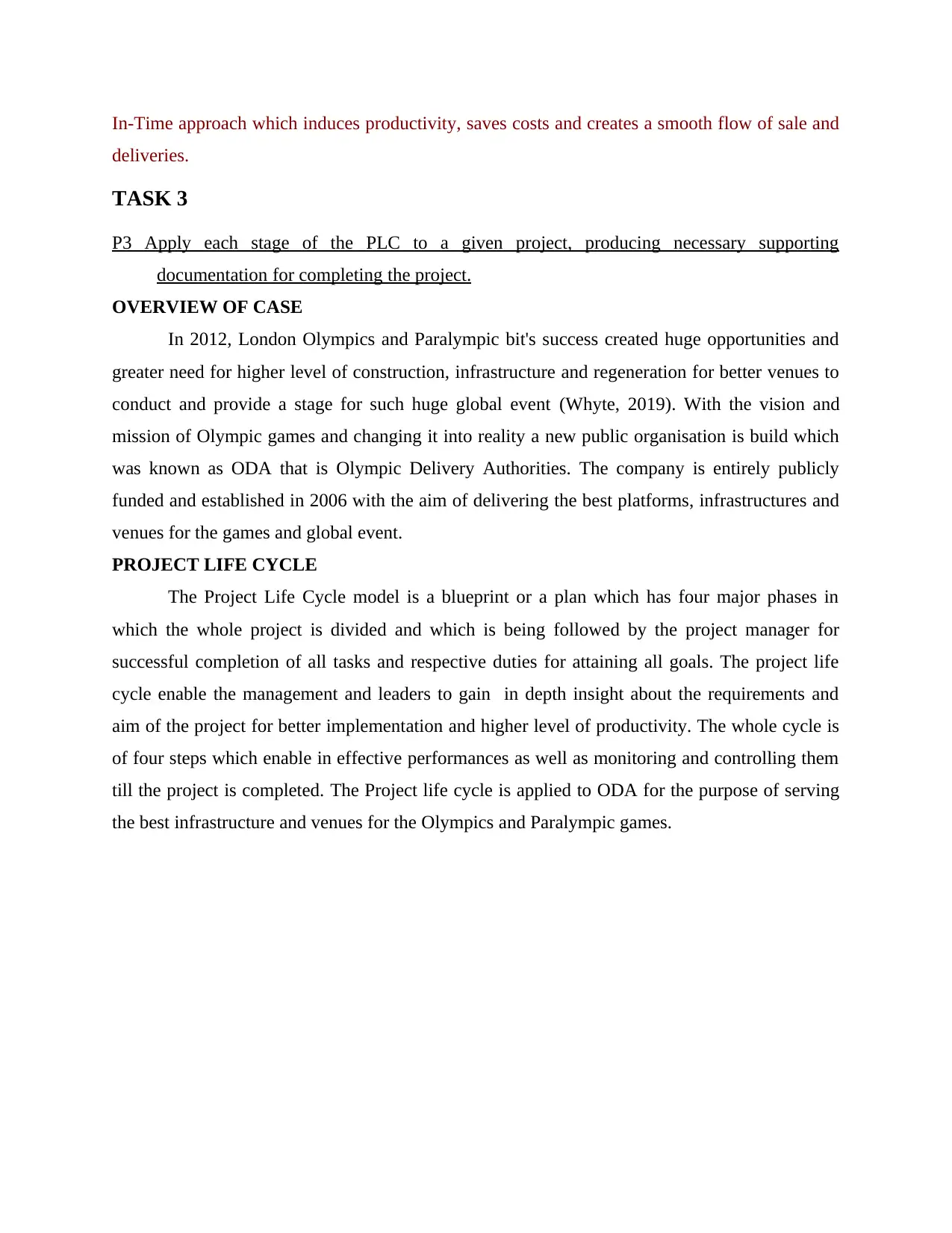
In-Time approach which induces productivity, saves costs and creates a smooth flow of sale and
deliveries.
TASK 3
P3 Apply each stage of the PLC to a given project, producing necessary supporting
documentation for completing the project.
OVERVIEW OF CASE
In 2012, London Olympics and Paralympic bit's success created huge opportunities and
greater need for higher level of construction, infrastructure and regeneration for better venues to
conduct and provide a stage for such huge global event (Whyte, 2019). With the vision and
mission of Olympic games and changing it into reality a new public organisation is build which
was known as ODA that is Olympic Delivery Authorities. The company is entirely publicly
funded and established in 2006 with the aim of delivering the best platforms, infrastructures and
venues for the games and global event.
PROJECT LIFE CYCLE
The Project Life Cycle model is a blueprint or a plan which has four major phases in
which the whole project is divided and which is being followed by the project manager for
successful completion of all tasks and respective duties for attaining all goals. The project life
cycle enable the management and leaders to gain in depth insight about the requirements and
aim of the project for better implementation and higher level of productivity. The whole cycle is
of four steps which enable in effective performances as well as monitoring and controlling them
till the project is completed. The Project life cycle is applied to ODA for the purpose of serving
the best infrastructure and venues for the Olympics and Paralympic games.
deliveries.
TASK 3
P3 Apply each stage of the PLC to a given project, producing necessary supporting
documentation for completing the project.
OVERVIEW OF CASE
In 2012, London Olympics and Paralympic bit's success created huge opportunities and
greater need for higher level of construction, infrastructure and regeneration for better venues to
conduct and provide a stage for such huge global event (Whyte, 2019). With the vision and
mission of Olympic games and changing it into reality a new public organisation is build which
was known as ODA that is Olympic Delivery Authorities. The company is entirely publicly
funded and established in 2006 with the aim of delivering the best platforms, infrastructures and
venues for the games and global event.
PROJECT LIFE CYCLE
The Project Life Cycle model is a blueprint or a plan which has four major phases in
which the whole project is divided and which is being followed by the project manager for
successful completion of all tasks and respective duties for attaining all goals. The project life
cycle enable the management and leaders to gain in depth insight about the requirements and
aim of the project for better implementation and higher level of productivity. The whole cycle is
of four steps which enable in effective performances as well as monitoring and controlling them
till the project is completed. The Project life cycle is applied to ODA for the purpose of serving
the best infrastructure and venues for the Olympics and Paralympic games.
Paraphrase This Document
Need a fresh take? Get an instant paraphrase of this document with our AI Paraphraser
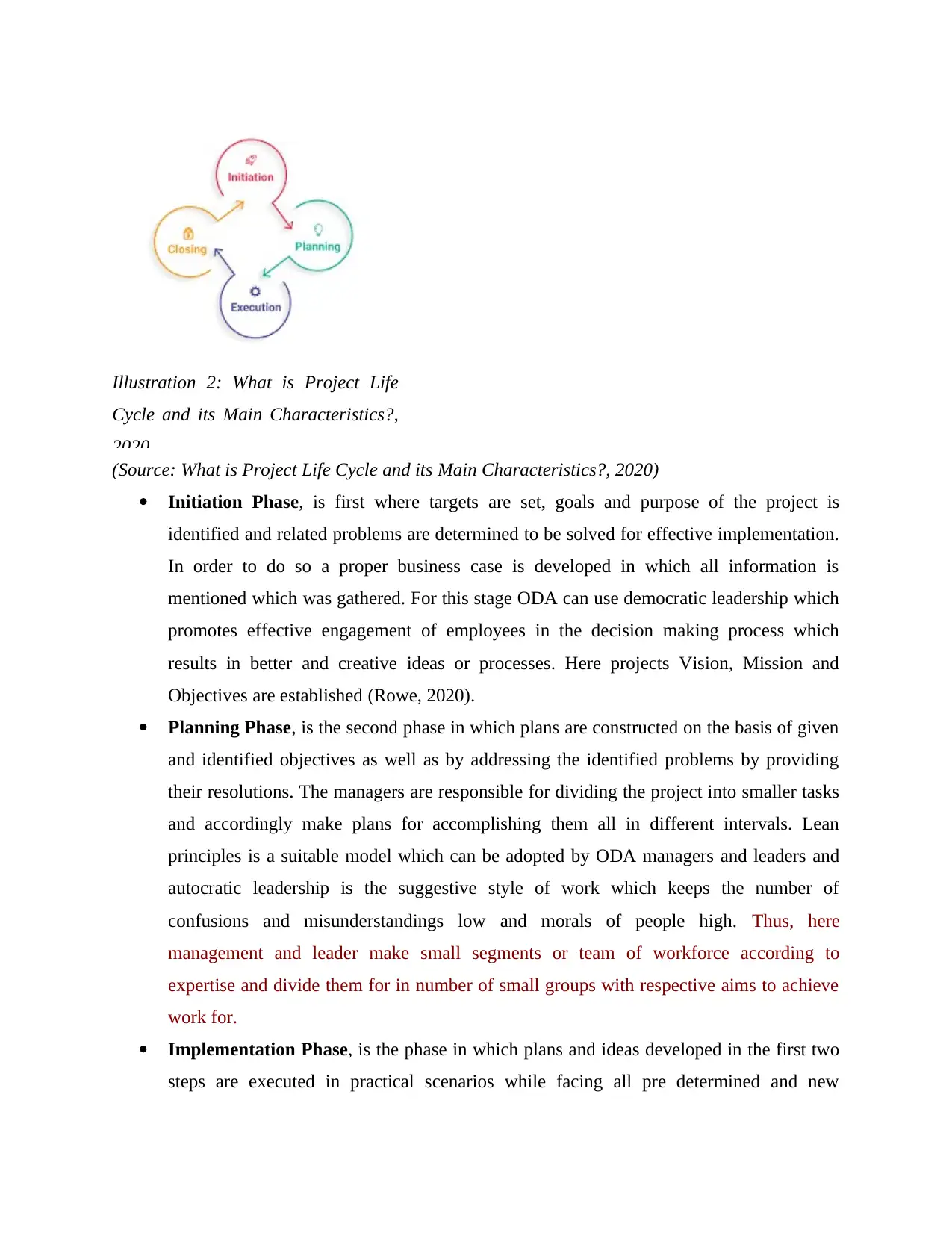
Illustration 2: What is Project Life
Cycle and its Main Characteristics?,
2020
(Source: What is Project Life Cycle and its Main Characteristics?, 2020)
Initiation Phase, is first where targets are set, goals and purpose of the project is
identified and related problems are determined to be solved for effective implementation.
In order to do so a proper business case is developed in which all information is
mentioned which was gathered. For this stage ODA can use democratic leadership which
promotes effective engagement of employees in the decision making process which
results in better and creative ideas or processes. Here projects Vision, Mission and
Objectives are established (Rowe, 2020).
Planning Phase, is the second phase in which plans are constructed on the basis of given
and identified objectives as well as by addressing the identified problems by providing
their resolutions. The managers are responsible for dividing the project into smaller tasks
and accordingly make plans for accomplishing them all in different intervals. Lean
principles is a suitable model which can be adopted by ODA managers and leaders and
autocratic leadership is the suggestive style of work which keeps the number of
confusions and misunderstandings low and morals of people high. Thus, here
management and leader make small segments or team of workforce according to
expertise and divide them for in number of small groups with respective aims to achieve
work for.
Implementation Phase, is the phase in which plans and ideas developed in the first two
steps are executed in practical scenarios while facing all pre determined and new
Cycle and its Main Characteristics?,
2020
(Source: What is Project Life Cycle and its Main Characteristics?, 2020)
Initiation Phase, is first where targets are set, goals and purpose of the project is
identified and related problems are determined to be solved for effective implementation.
In order to do so a proper business case is developed in which all information is
mentioned which was gathered. For this stage ODA can use democratic leadership which
promotes effective engagement of employees in the decision making process which
results in better and creative ideas or processes. Here projects Vision, Mission and
Objectives are established (Rowe, 2020).
Planning Phase, is the second phase in which plans are constructed on the basis of given
and identified objectives as well as by addressing the identified problems by providing
their resolutions. The managers are responsible for dividing the project into smaller tasks
and accordingly make plans for accomplishing them all in different intervals. Lean
principles is a suitable model which can be adopted by ODA managers and leaders and
autocratic leadership is the suggestive style of work which keeps the number of
confusions and misunderstandings low and morals of people high. Thus, here
management and leader make small segments or team of workforce according to
expertise and divide them for in number of small groups with respective aims to achieve
work for.
Implementation Phase, is the phase in which plans and ideas developed in the first two
steps are executed in practical scenarios while facing all pre determined and new
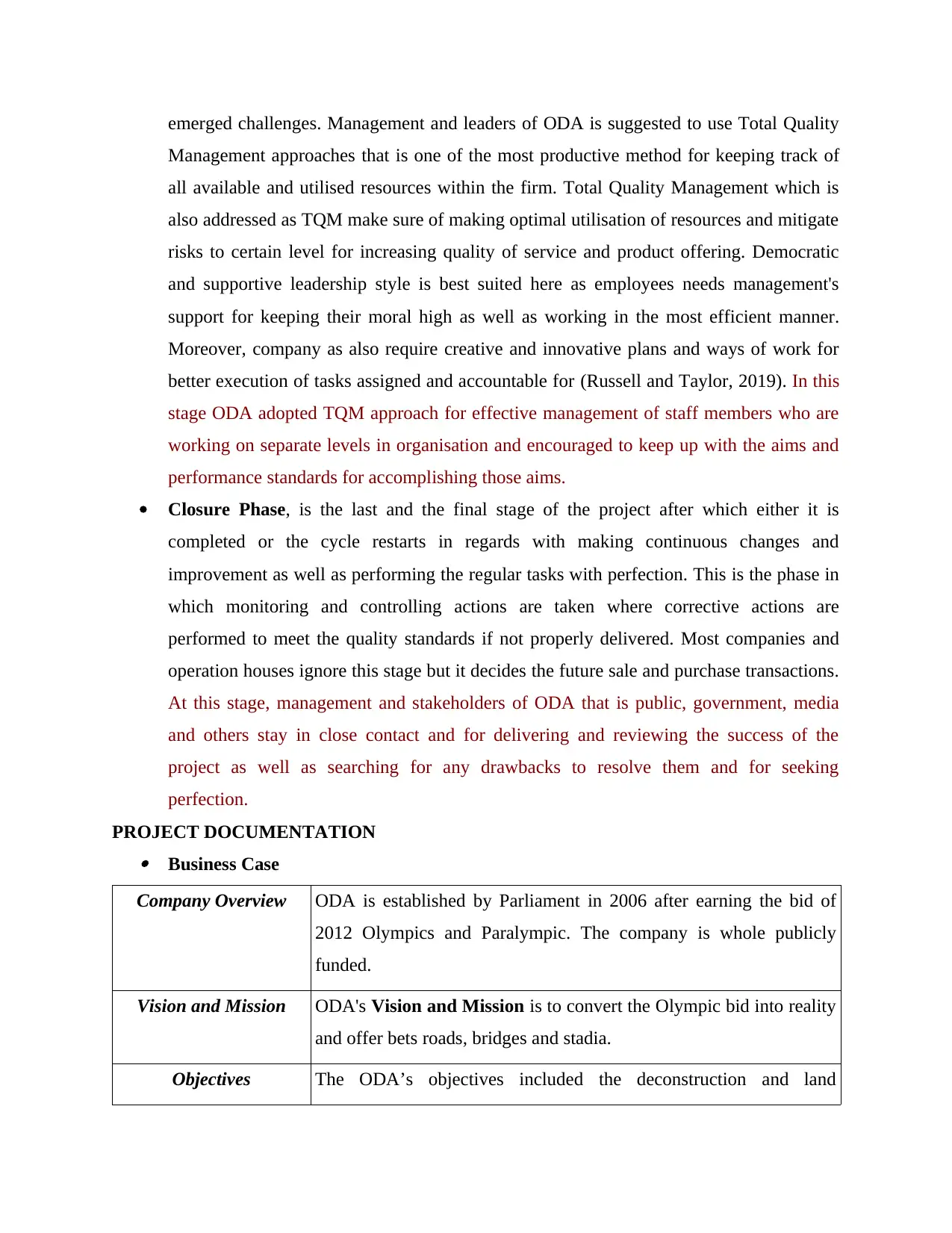
emerged challenges. Management and leaders of ODA is suggested to use Total Quality
Management approaches that is one of the most productive method for keeping track of
all available and utilised resources within the firm. Total Quality Management which is
also addressed as TQM make sure of making optimal utilisation of resources and mitigate
risks to certain level for increasing quality of service and product offering. Democratic
and supportive leadership style is best suited here as employees needs management's
support for keeping their moral high as well as working in the most efficient manner.
Moreover, company as also require creative and innovative plans and ways of work for
better execution of tasks assigned and accountable for (Russell and Taylor, 2019). In this
stage ODA adopted TQM approach for effective management of staff members who are
working on separate levels in organisation and encouraged to keep up with the aims and
performance standards for accomplishing those aims.
Closure Phase, is the last and the final stage of the project after which either it is
completed or the cycle restarts in regards with making continuous changes and
improvement as well as performing the regular tasks with perfection. This is the phase in
which monitoring and controlling actions are taken where corrective actions are
performed to meet the quality standards if not properly delivered. Most companies and
operation houses ignore this stage but it decides the future sale and purchase transactions.
At this stage, management and stakeholders of ODA that is public, government, media
and others stay in close contact and for delivering and reviewing the success of the
project as well as searching for any drawbacks to resolve them and for seeking
perfection.
PROJECT DOCUMENTATION Business Case
Company Overview ODA is established by Parliament in 2006 after earning the bid of
2012 Olympics and Paralympic. The company is whole publicly
funded.
Vision and Mission ODA's Vision and Mission is to convert the Olympic bid into reality
and offer bets roads, bridges and stadia.
Objectives The ODA’s objectives included the deconstruction and land
Management approaches that is one of the most productive method for keeping track of
all available and utilised resources within the firm. Total Quality Management which is
also addressed as TQM make sure of making optimal utilisation of resources and mitigate
risks to certain level for increasing quality of service and product offering. Democratic
and supportive leadership style is best suited here as employees needs management's
support for keeping their moral high as well as working in the most efficient manner.
Moreover, company as also require creative and innovative plans and ways of work for
better execution of tasks assigned and accountable for (Russell and Taylor, 2019). In this
stage ODA adopted TQM approach for effective management of staff members who are
working on separate levels in organisation and encouraged to keep up with the aims and
performance standards for accomplishing those aims.
Closure Phase, is the last and the final stage of the project after which either it is
completed or the cycle restarts in regards with making continuous changes and
improvement as well as performing the regular tasks with perfection. This is the phase in
which monitoring and controlling actions are taken where corrective actions are
performed to meet the quality standards if not properly delivered. Most companies and
operation houses ignore this stage but it decides the future sale and purchase transactions.
At this stage, management and stakeholders of ODA that is public, government, media
and others stay in close contact and for delivering and reviewing the success of the
project as well as searching for any drawbacks to resolve them and for seeking
perfection.
PROJECT DOCUMENTATION Business Case
Company Overview ODA is established by Parliament in 2006 after earning the bid of
2012 Olympics and Paralympic. The company is whole publicly
funded.
Vision and Mission ODA's Vision and Mission is to convert the Olympic bid into reality
and offer bets roads, bridges and stadia.
Objectives The ODA’s objectives included the deconstruction and land
⊘ This is a preview!⊘
Do you want full access?
Subscribe today to unlock all pages.

Trusted by 1+ million students worldwide
1 out of 16
Related Documents
Your All-in-One AI-Powered Toolkit for Academic Success.
+13062052269
info@desklib.com
Available 24*7 on WhatsApp / Email
![[object Object]](/_next/static/media/star-bottom.7253800d.svg)
Unlock your academic potential
Copyright © 2020–2025 A2Z Services. All Rights Reserved. Developed and managed by ZUCOL.



